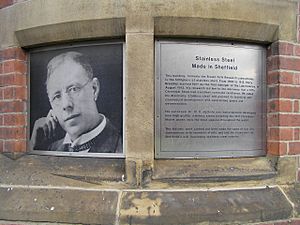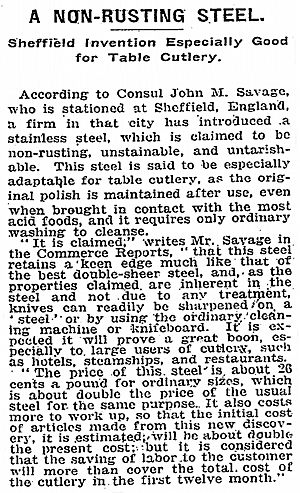Harry Brearley facts for kids
Quick facts for kids
Harry Brearley
|
|
|---|---|
 |
|
| Born | 18 February 1871 Sheffield, England
|
| Died | 14 July 1948 (aged 77) |
| Nationality | English |
| Occupation | Metallurgist, inventor |
| Known for | The invention of stainless steel |

Harry Brearley was a clever English scientist who invented "rustless steel," which we now call stainless steel. He was from Sheffield, England. His amazing invention made cutlery (like knives and forks) much cheaper for everyone. It also helped Sheffield's famous cutlery industry grow even bigger!
Contents
Harry Brearley's Early Life
Harry Brearley was born in Sheffield, England, on February 18, 1871. His parents were John and Jane Brearley. He left school when he was just twelve years old to start working. His first job was as a laborer in a steel factory. Later, he became a helper in the factory's chemical lab. He married Helen Theresa Crank on October 23, 1895.
Brearley spent many years learning about how steel is made and how to test its chemicals. He studied at home and went to evening classes. By his early thirties, he was known as a very skilled metallurgist. A metallurgist is a scientist who studies metals. In 1908, he was chosen to lead a special research project. This project was at Brown Firth Laboratories and was paid for by two big steel companies in Sheffield.
Later Career and Legacy
After working at Brown Firth, Brearley joined Brown Bayley Steel Works in Sheffield. He became a director there in 1925. In 1941, he started The Freshgate Trust Foundation. This foundation helps people from humble backgrounds get educational and cultural chances. The foundation is still helping people today!
Harry Brearley passed away on July 14, 1948, in Torquay.
The Invention of Stainless Steel
Just before the First World War, countries were making many more weapons. But there was a problem: the inside of gun barrels wore out too quickly. This was because of the high heat. Brearley started looking for new types of steel. He wanted steel that could handle very high temperatures better.
He began adding chromium to steel. Chromium was known to make metal melt at a higher temperature. He wanted to see how different amounts of carbon (around 0.2%) and chromium (from 6% to 15%) would change the steel.
An Accidental Discovery

To study his new steel, Brearley needed to polish and clean the metal samples. For regular steel, a weak acid solution works well. But Brearley found that his new chromium steels were very hard to clean with chemicals. They resisted the acid! This was a big clue.
Before Brearley's work, knives made of regular steel would rust easily. You had to polish them often. Only expensive silver cutlery could avoid rust. Brearley tested his new steel with food acids, like vinegar and lemon juice. The results were very good! The steel didn't rust.
He first called his invention "rustless steel." But a man named Ernest Stuart from a local cutlery company had a better idea. He suggested the name "stainless steel," which sounded much nicer. On August 13, 1913, Brearley made what we consider the first true stainless steel. It was a metal mix with 0.24% carbon and 12.8% chromium. He received a special award, the Bessemer Gold Medal, in 1920 for his amazing work.
Research on stainless steel stopped during World War I. But it started again in the 1920s. Brearley left Brown Firth Laboratories in 1915 because of disagreements about who owned the rights to his invention. His replacement, Dr. W.H. Hatfield, later created an even better stainless steel. It's called "18/8 stainless steel" and includes nickel. This type is still used a lot today!
Memorials to Harry Brearley
To celebrate 100 years since his invention, a huge mural of Brearley was painted. It is 42 feet (13 m) tall and is on the side of a building in Howard Street, Sheffield. The artist who painted it is Sarah Yates, also known as "Faunagraphic."
Books by Harry Brearley
- H. Brearley & F. Ibbotson (1902) The Analysis of Steel-works Materials
- H. Brearley (1911) The Heat Treatment of Tool Steel
- H. Brearley (1914) The Case-Hardening of Steel
- H. Brearley (1918) The Heat Treatment of Steel
- H. Brearley (1933) Steel Makers
- H. Brearley (1941) Knotted String (his autobiography)
See also
 In Spanish: Harry Brearley para niños
In Spanish: Harry Brearley para niños
- List of people from Sheffield
- Elwood Haynes
- Portland Works

